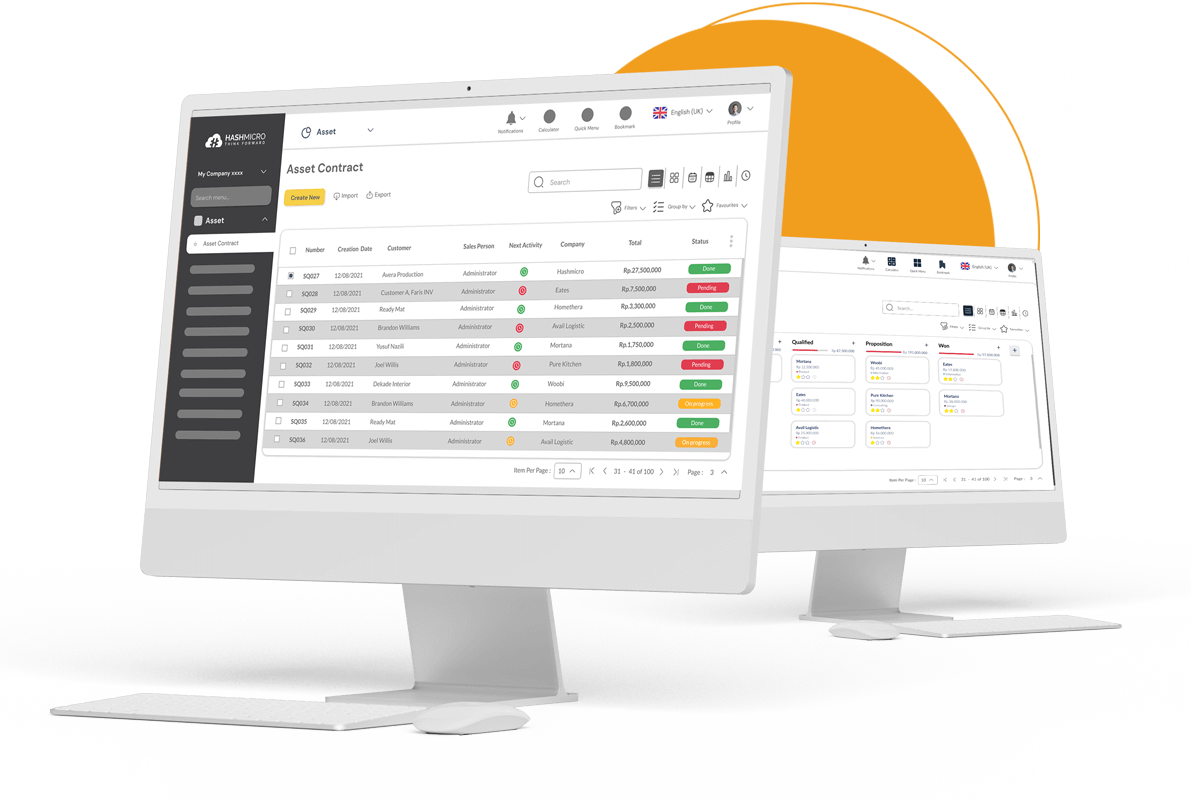Unexpected equipment failures can disrupt operations, reduce productivity, and lead to significant financial losses. Without proper maintenance tracking, unplanned downtime can quickly damage your business and reputation. But what if you could prevent these setbacks with a smarter solution?
With HashMicro’s CMMS software, you can efficiently monitor every asset, schedule maintenance proactively, and keep your equipment in peak condition. Say goodbye to costly downtime and hello to seamless operations.
Let’s explore how CMMS software can transform your maintenance management and drive long-term business success!
Key Takeaways
|
Table of Contents

CMMS Meaning
A CMMS (Computerized Maintenance Management System) is a software solution that helps businesses plan, track, and optimize maintenance activities. It centralizes all maintenance tasks, schedules, and workflows, ensuring that assets are properly maintained and operational downtime is minimized.
The software provides real-time visibility, reducing manual processes and errors. With detailed maintenance histories and performance metrics, it also helps businesses make informed decisions to improve asset reliability and maximize their return on investment.
Benefits of CMMS Software for Filipino Businesses
CMMS software offers significant advantages that can transform maintenance management for Filipino businesses, enhancing both efficiency and productivity. By leveraging real-time data and automated processes, companies can ensure assets remain valuable and in top condition, reducing unexpected breakdowns.
Here’s a breakdown of the key benefits that highlight why this is essential for operational success:
- Real-time Monitoring and Control
CMMS software provides a comprehensive view of assets, enabling better tracking and management. It reduces failure risks and improves visibility into asset health for proactive management. - Streamlined Processes Through Automation
Automation in asset management reduces manual scheduling and tracking efforts. It minimizes errors and ensures maintenance tasks are completed on time. - Preventive Maintenance to Avoid Breakdowns
This software optimizes maintenance schedules to lower costs and extend equipment lifespan. Its predictive features address issues before they escalate into major repairs. - Comprehensive Maintenance Records for Compliance
A CMMS records all maintenance activities, inspections, and repairs. This facilitates easy audits and compliance with industry standards. - Data-Driven Decision-Making
It collect data on asset performance to identify trends and predict failures. This data shapes strategies for continuous improvement in maintenance operations.
Incorporating CMMS software into your business processes streamlines operations, reduces costs, and ensures regulatory compliance, positioning your company for long-term success. By optimizing maintenance activities, Filipino businesses can not only extend asset life but also make data-driven decisions that enhance overall productivity.
How Does CMMS Software Work?
CMMS software streamlines the management, tracking, and optimization of maintenance activities, enabling businesses to enhance the availability and efficiency of physical assets such as machinery, vehicles, equipment, and infrastructure. Below is a quick overview of key features offered by CMMS solutions:
- Work order management: Automates and simplifies the creation, assignment, and tracking of maintenance tasks, ensuring smoother workflows and timely execution.
- Resource and labor scheduling: Enables efficient allocation of human and material resources, boosting productivity and operational efficiency.
- Asset registry: Offers a centralized database for managing and tracking all assets within the organization, improving oversight and organization.
- Condition monitoring: Utilizes IoT sensors to continuously monitor the health and performance of assets, providing early alerts to maintenance teams when anomalies are detected.
- Predictive maintenance: Analyzes historical and real-time data to anticipate when equipment will require servicing, helping to prevent unexpected breakdowns or failures.
- Reporting and analytics: Delivers detailed data visualizations and tracking tools to monitor key performance indicators (KPIs) and make informed decisions.
- Parts and inventory management: Provides visibility into the availability, location, and status of spare parts, ensuring the right components are ready when needed.
- Mobile maintenance: Allows technicians to securely access information, initiate tasks, and manage maintenance activities remotely using mobile devices.
- Auditing and compliance tracking: This ensures that maintenance operations are documented and adhere to industry and regional regulations, simplifying compliance verification.
Industries Shifted from CMMS to EAM for Managing Assets
EAM software is a highly adaptable tool valuable across a wide range of industries. Its ability to optimize maintenance processes makes it essential for improving operations in various sectors. Below are examples of five types of businesses or industries that can greatly benefit from implementing EAM solutions:
- Telecom and utilities: These industries face intricate field service management challenges, where maintaining service uptime is critical, impacting millions of customers. Advanced EAM solutions enable proactive monitoring and maintenance of infrastructure, such as cell towers, substations, and utility poles. They ensure minimal service interruptions and quick restorations when they occur, which helps maintain customer satisfaction and comply with service level agreements (SLAs).
- Fleet management: Efficient fleet management requires coordinating multiple components, schedules, and preventive maintenance activities. EAM tools simplify these tasks by offering centralized record-keeping and predictive maintenance features. These features extend the fleet’s lifespan and minimize downtime due to breakdowns, leading to cost savings and more streamlined operations.
- Healthcare: Reliable and well-maintained equipment is crucial in the healthcare industry, where patient safety is paramount. As medical devices become increasingly complex, healthcare providers depend on robust EAM solutions to ensure proper maintenance protocols, enhance outcomes, and ensure equipment functionality when needed most.
- Oil and gas: In this high-risk industry, asset failure can result in significant financial losses and environmental harm. EAM is critical in predictive and preventive maintenance, enabling oil and gas companies to meet stringent compliance regulations and maintain safe, efficient operations.
- Manufacturing: As companies face rising costs and increasing competition, EAM gives them a competitive advantage by ensuring that machinery is kept in optimal condition. It helps minimize downtime, boosts overall productivity, and provides greater visibility into regulatory compliance, which is particularly complex in this sector.
- Construction: With expensive machinery, demanding clients, and strict deadlines, construction companies rely on reliable asset management to maintain high-value assets. EAM systems ensure that equipment remains in peak condition, supporting teams in completing projects on time and within budget.
What Are the Key Features of CMMS Maintenance Software?
CMMS maintenance software offers a wide range of features designed to streamline maintenance operations and improve asset management. Below are some of the key functionalities that make CMMS an essential tool for businesses looking to enhance their maintenance processes.
- Mobile responsive: A modern CMMS system should be user-friendly and accessible across various devices, allowing technicians and field personnel to easily access procedures and documentation, check part availability, create orders, review maintenance history, ensure compliance, and update work orders.
- Intuitive navigation: User adoption plays a crucial role in the success of a CMMS implementation. Software that is simple to use and intuitive is more likely to be embraced by employees. Therefore, it’s important to choose a CMMS system that aligns with your team’s processes and effectively addresses their maintenance requirements.
- Easy to integrate: Your CMMS should seamlessly integrate with other essential systems and equipment to enable your team to efficiently capture, analyze, and use vital data. This integration is made simple with Accruent’s Maintenance Connection RESTful API, which quickly connects key applications to your CMMS.
- Full work order visibility: Efficient facility maintenance depends on seamless work order management and field service execution. A reliable CMMS supports this by enabling users to review, prioritize, assign, schedule, and track work orders along with related maintenance tasks. It also offers comprehensive visibility into work orders, work order history, part usage history, and more.
CMMS vs. EAM: What’s the Difference?
While both CMMS and Enterprise Asset Management (EAM) systems focus on asset management, they serve different purposes. A CMMS primarily handles maintenance management by providing tools for scheduling, tracking, and optimizing maintenance tasks.
In contrast, an EAM system offers broader asset lifecycle management, including procurement and financial management. EAM systems are ideal for large organizations with diverse asset portfolios. However, a CMMS provides the essential features to effectively manage maintenance activities and improve asset performance.
CMMS vs. ERP: Which One Do You Need?
Enterprise Resource Planning (ERP) systems and CMMS software both play roles in asset management but have different focuses. An ERP system integrates various business functions, including finance, HR, and more. While it offers a holistic view of operations, it may not provide the specialized maintenance management features of a CMMS.
Combining a CMMS with an ERP system can create a more comprehensive solution, merging the operational insights of ERP with the detailed maintenance management capabilities of a CMMS.
Choosing the Right CMMS for Your Business
Selecting the right CMMS software is a crucial decision that can greatly impact the efficiency and success of your operations. It’s essential to choose a system that not only meets your current needs but also has the potential to grow alongside your business. Here are key factors to consider when evaluating CMMS options for your company:
- Functionality
Ensure that it provides essential features like work order management and preventive maintenance scheduling. Advanced functionalities like cost reporting and GPS tracking can further boost asset visibility. - Ease of Use
The software should have a user-friendly, intuitive interface for easy navigation. Features like QR code scanning streamline processes and enhance accessibility for all team members. - Scalability
Choose a CMMS that can expand with your business needs over time. It should handle more assets and users without losing performance quality. - Integration
Both software must integrate smoothly with other systems, such as ERP or facility management software. This ensures seamless data sharing and a unified view of asset management. - Vendor Support
Opt for a CMMS vendor known for strong customer support and service. Comprehensive support is vital for managing complex issues and maintaining compliance with regulations.
Taking the time to select the right CMMS software ensures your business can streamline operations and adapt to changing needs. By considering factors like functionality, scalability, and support, you set the foundation for improved maintenance efficiency and long-term success.
Implementing HashMicro’s CMMS Software to Boost Efficiency
Integrating HashMicro’s CMMS software into your business operations can revolutionize how you handle maintenance and asset management. By utilizing this powerful tool, companies can ensure that their assets are maintained efficiently, reducing both downtime and maintenance costs.
Here’s a look at some key features of HashMicro’s CMMS that can help streamline your processes:
- Asset Comprehensive Cost Reporting
The software provides detailed cost reporting for all assets, offering insights into maintenance expenses. This feature allows for better budget management and strategic decision-making to optimize asset performance. - Asset GPS Tracking
HashMicro’s CMMS includes real-time GPS tracking, giving a clear overview of asset locations. This enhances security and allows for efficient asset utilization, reducing the risk of loss or unauthorized usage. - QR Code Scanning for Facility Requests
The system simplifies facility requests by enabling QR code scanning for quick asset identification. This speeds up maintenance processes and makes it easier for employees to report issues. - Asset Maintenance Budget
The software provides tools to set and manage maintenance budgets, allowing businesses to control maintenance expenditures effectively. Companies can avoid unexpected expenses and financial stability by forecasting costs. - Repair Order Management – Integrated with Inventory
HashMicro’s CMMS integrates repair order management with inventory, streamlining parts ordering and usage. This integration ensures that necessary components are always available, reducing downtime and maintenance.
Implementing HashMicro’s CMMS can significantly improve your operational efficiency, keeping your business profitable. With automated processes and advanced features, it is a comprehensive solution for optimizing asset maintenance. If you are still wondering what software to use for managing assets, you can read more about asset management software recommendations here.
Conclusion
Implementing CMMS software can greatly enhance your business operations by streamlining maintenance and reducing costs. With features like real-time monitoring and automated processes, it ensures assets are well-maintained. Understanding the differences between CMMS, EAM, and ERP is key to selecting the right solution for success.
Choosing the right CMMS, such as HashMicro’s, provides valuable tools like cost reporting and GPS tracking. These features from asset management systems offer insights for better budget control and decision-making. If you’re unsure which software to use, explore HashMicro’s software and try our free demo today.
Frequently Asked Question
-
What does CMMS software do?
This software helps businesses streamline maintenance tasks, optimize asset management, and reduce downtime. It provides real-time visibility into maintenance activities, enabling proactive management of assets.
-
What is an example of a CMMS?
An example of a CMMS is HashMicro’s software, which offers features like automated scheduling and asset tracking. Other examples include Fiix, Hippo, and Maintenance Connection, each catering to various industry needs.
-
How do you implement a CMMS system?
To implement a this system, start by assessing your business needs and selecting suitable software. Then, train your team, migrate existing data, and set up workflows for effective maintenance management.






















